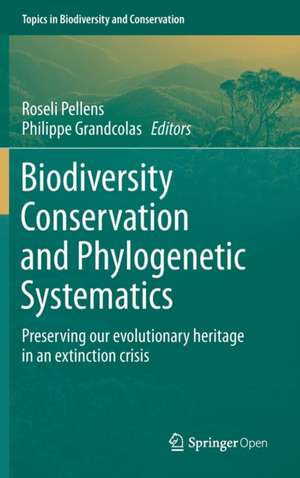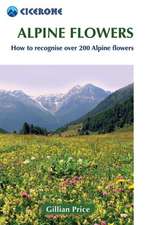Biodiversity Conservation and Phylogenetic Systematics: Preserving our evolutionary heritage in an extinction crisis: Topics in Biodiversity and Conservation, cartea 14
Editat de Roseli Pellens, Philippe Grandcolasen Limba Engleză Hardback – mar 2016
| Toate formatele și edițiile | Preț | Express |
|---|---|---|
| Paperback (1) | 427.92 lei 6-8 săpt. | |
| Springer International Publishing – 7 apr 2018 | 427.92 lei 6-8 săpt. | |
| Hardback (1) | 435.38 lei 6-8 săpt. | |
| Springer International Publishing – mar 2016 | 435.38 lei 6-8 săpt. |
Din seria Topics in Biodiversity and Conservation
- 24%
 Preț: 1605.63 lei
Preț: 1605.63 lei - 18%
 Preț: 1239.49 lei
Preț: 1239.49 lei - 18%
 Preț: 947.50 lei
Preț: 947.50 lei - 18%
 Preț: 1218.21 lei
Preț: 1218.21 lei - 18%
 Preț: 942.31 lei
Preț: 942.31 lei - 18%
 Preț: 944.51 lei
Preț: 944.51 lei - 15%
 Preț: 646.62 lei
Preț: 646.62 lei - 24%
 Preț: 806.76 lei
Preț: 806.76 lei - 18%
 Preț: 1114.65 lei
Preț: 1114.65 lei - 18%
 Preț: 1126.35 lei
Preț: 1126.35 lei - 18%
 Preț: 1834.27 lei
Preț: 1834.27 lei - 18%
 Preț: 1019.49 lei
Preț: 1019.49 lei - 18%
 Preț: 1236.38 lei
Preț: 1236.38 lei - 18%
 Preț: 1231.47 lei
Preț: 1231.47 lei - 18%
 Preț: 1236.38 lei
Preț: 1236.38 lei - 18%
 Preț: 1230.66 lei
Preț: 1230.66 lei - 18%
 Preț: 1232.71 lei
Preț: 1232.71 lei - 18%
 Preț: 1376.53 lei
Preț: 1376.53 lei - 18%
 Preț: 944.51 lei
Preț: 944.51 lei
Preț: 435.38 lei
Nou
Puncte Express: 653
Preț estimativ în valută:
83.32€ • 90.47$ • 69.99£
83.32€ • 90.47$ • 69.99£
Carte tipărită la comandă
Livrare economică 22 aprilie-06 mai
Preluare comenzi: 021 569.72.76
Specificații
ISBN-13: 9783319224602
ISBN-10: 3319224603
Pagini: 250
Ilustrații: XVII, 390 p. 79 illus., 51 illus. in color.
Dimensiuni: 155 x 235 x 30 mm
Greutate: 0.75 kg
Ediția:1st ed. 2016
Editura: Springer International Publishing
Colecția Springer
Seria Topics in Biodiversity and Conservation
Locul publicării:Cham, Switzerland
ISBN-10: 3319224603
Pagini: 250
Ilustrații: XVII, 390 p. 79 illus., 51 illus. in color.
Dimensiuni: 155 x 235 x 30 mm
Greutate: 0.75 kg
Ediția:1st ed. 2016
Editura: Springer International Publishing
Colecția Springer
Seria Topics in Biodiversity and Conservation
Locul publicării:Cham, Switzerland
Public țintă
ResearchCuprins
Phylogenetics and conservation biology: drawing a path into the diversity of life.- The value of phylogenetic diversity.- The PD phylogenetic diversity framework: linking evolutionary history to feature diversity for biodiversity conservation.- Reconsidering the loss of evolutionary history: how does non-random extinction prune the tree-of-life?- Phylogenetics and conservation in New Zealand: the long and the short of it.- What is the meaning of extreme phylogenetic diversity? The case of phylogenetic relict species.- Using phylogenetic dissimilarities among sites for biodiversity assessments and conservation.- Phylogenetic diversity measures and their decomposition: a framework based on hill numbers.- Split diversity: measuring and optimizing biodiversity using phylogenetic split networks.- The rarefaction of phylogenetic diversity: formulation, extension and application.- Support in area prioritization using phylogenetic information.- Assessing hotspots of evolutionary history with data from multiple phylogenies: an analysis of endemic clades from New Caledonia.- Representing hotspots of evolutionary history in systematic conservation planning for European mammals.- Priorities for conservation of the evolutionary history of amphibians in the cerrado.- Global spatial analyses of phylogenetic conservation priorities for aquatic mammals.- Metapopulation capacity meets evolutionary distinctness: spatial fragmentation complements phylogenetic rarity in prioritization. - Patterns of species, phylogenetic and mimicry diversity of clearwing butterflies in the Neotropics.- Conservation of phylogenetic diversity in Madagascar’s largest endemic plant family, Sarcolaenaceae.- The future of phylogenetic systematics in conservation biology: linking biodiversity and society.
Textul de pe ultima copertă
Phylogenetic diversity is now a key concept for biodiversity conservation due to its link to option value, evolutionary potential and to the possibility of guiding conservation across scales. Present facilities for obtaining molecular sequences and metagenomes are powering this research field, rendering available detailed information of phylogenetic diversity for a wide taxonomic sample in a short time frame. Along with modern methods of Systematic Conservation Planning this will certainly contribute to more explicit identification of conservation priorities and options.
This book brings an updated state of the art of phylogenetic diversity in conservation biology. Nineteen chapters written by scientists from research institutions of fourteen countries demonstrate that approaches for preserving the evolutionary heritage are now very tuned into human impacts and sustainability issues. The questions, methods and applications around which it is organized show the importance of phylogenetic diversity in avoiding biodiversity losses in the present extinction crisis. They touch important points such as the way we value phylogenetic diversity, the importance of thinking at a much wider sample of the Tree of Life, the choice of adequate measures. In methods section, new solutions, such as dealing with abundances, sampling effort, or with information coming from conflicting phylogenetic trees are provided. Application section includes study cases of different groups of organi
sms, such as mammals, amphibians, butterflies and plants, in aquatic and terrestrial ecosystems, showing that phylogenetic diversity can be applied in a very wide range of situations, including as a way for predicting conservation status of species. This highlights the interest of this book not only for students and scientists of related disciplines but also for stakeholders and policy-makers working on the implementation of global, regional, and local agendas for biodiversity conservation.
This book brings an updated state of the art of phylogenetic diversity in conservation biology. Nineteen chapters written by scientists from research institutions of fourteen countries demonstrate that approaches for preserving the evolutionary heritage are now very tuned into human impacts and sustainability issues. The questions, methods and applications around which it is organized show the importance of phylogenetic diversity in avoiding biodiversity losses in the present extinction crisis. They touch important points such as the way we value phylogenetic diversity, the importance of thinking at a much wider sample of the Tree of Life, the choice of adequate measures. In methods section, new solutions, such as dealing with abundances, sampling effort, or with information coming from conflicting phylogenetic trees are provided. Application section includes study cases of different groups of organi
sms, such as mammals, amphibians, butterflies and plants, in aquatic and terrestrial ecosystems, showing that phylogenetic diversity can be applied in a very wide range of situations, including as a way for predicting conservation status of species. This highlights the interest of this book not only for students and scientists of related disciplines but also for stakeholders and policy-makers working on the implementation of global, regional, and local agendas for biodiversity conservation.
Caracteristici
This book provides a fast and reliable way of understanding the role of phylogenetic diversity in present biodiversity conservation frame work It can be very useful for graduate, master and PhD students as it discusses basic questions such as the way we value phylogenetic diversity, gives guidelines for the choice of measures and provides detailed information on new methodological solutions The examples given here show both that it can be applied to many cases and be very useful to policy makers.









